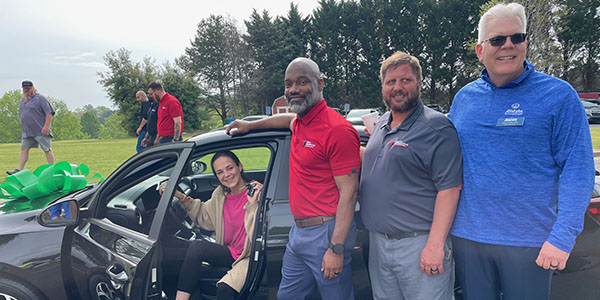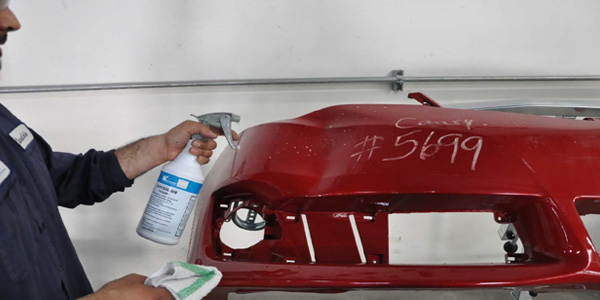
Repairing plastic bumpers using adhesives isn’t easy. And when shops fumble, it often happens on the first step in the process.
“I’ve seen a number of shops out there, when they do fail, they forget to clean the bumpers,” explained Toby Chess, co-chair of the Collision Industry Conference (CIC) Technical Committee, during an April 11 presentation in Westminster, Colo.
For single-sided plastic repair, Chess emphasized that the first step is to wash both sides of the bumper with soap and water. Chess recommended Dove, Palmolive or some other soap that has grease-cutting ingredients in it.
The next step is to degrease the repair area with a wax-and-grease remover.
Step 3 is to remove the dent using heat. Chess said there are infrared curing lamps on the market that serve as effective tools for removing dents in bumpers.
The next step is to use a dolly to push out the dent from the backside.
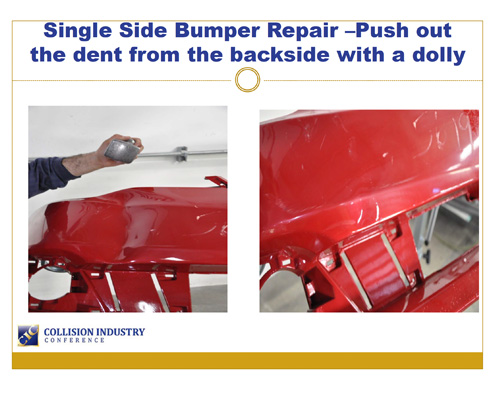
Then, spray the repaired area with cold water to harden the soft plastic. It’s a step that “most people don’t understand,” Chess asserted.
“They heat that bumper up and then they let it air-cool,” he added.
For single-sided bumper repair, the next step is to sand the area – at a low speed – with 120-grit sandpaper. After that, clean the repaired area with wax-and-grease remover to get rid of any mold-release agent that might have come to the surface during the heating and sanding.
“Get in the habit of cleaning these bumpers before putting any materials down,” Chess said.
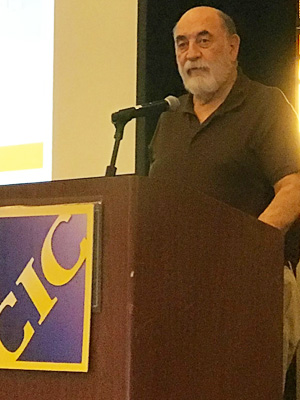
Next, apply a surface modifier – also known as an adhesion promoter – to help the epoxy stick to the plastic.
For the next step, it’s important to equalize the product cartridge before applying the epoxy to the vehicle. This is done by dispensing a small amount of the epoxy to ensure that there’s a proper mixture and that it’s coming out of both sides of the cartridge.
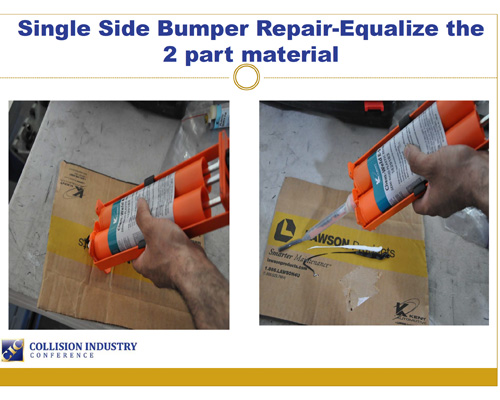
After equalizing the two-part epoxy, apply and spread it over the repaired area. Then sand the repaired area with 220-grit sandpaper.
Next, apply guide coat and check for low spots. Then, clean the repaired area again with a wax-and-grease remover. After that, apply a high-build flexible primer.
According to Chess and Yeung, the general rules for two-sided plastic repair are similar to single-sided plastic repair:
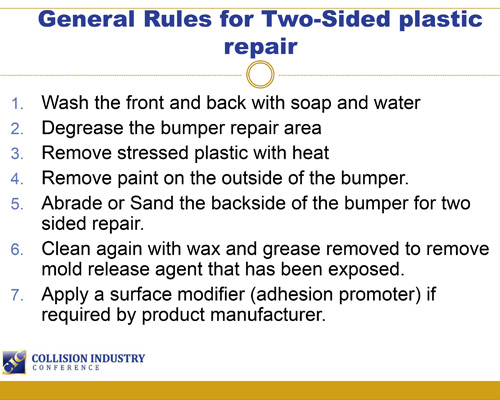
Yeung emphasized that these are general guidelines, and that it would’ve been impossible to cover every possible scenario for bumper repair in the duo’s CIC presentation. He noted that all of the adhesive manufacturers – from 3M to Kent Automotive to SEM Products – have specific instructions for how to use their products in the course of a bumper repair.
“We strongly recommend that you follow those guidelines for the best repair,” Yeung said.
Things to Consider Before Repairing Plastic Bumpers
Chess and Yeung offered a list of question to consider before attempting to repair a plastic bumper.
- Repair cost – Is it cheaper to fix the bumper or buy a new one?
- Lifetime warranty – If your shop offers lifetime warranties on collision work, will the repaired bumper stand the test of time?
- Can the repairs be seen? – “There’s nothing worse than somebody looking at it and you can see a glob of adhesive over the top of it,” Chess said.
- Will the repair stand up to stress?
- What does the OEM say about bumper repair? – Because bumpers might contain radar and other sophisticated electronics, some automakers recommend replacement over repair.
- What is the availability of another bumper?
- Warpage or memory – “Some of these bumpers have to have plastic over the whole length of the thing because it’s warped,” Chess said.
- Damage to the parking sensors
- Has the bumper been repaired and/or repainted prior to arriving in your shop?
Chess pointed out that “there are a number of people who work on the insurance side … telling us how to fix bumpers with no training.” Ultimately, though, determining how to fix the bumper – and whether to repair or replace the bumper – is up to the collision repairer.
“Let the repairers make that decision,” Chess asserted, “not some two-week wonder who went to a one-hour seminar saying, ‘Oh, I know how to fix bumpers.’”
A PDF of their presentation is available on the CIC website.

